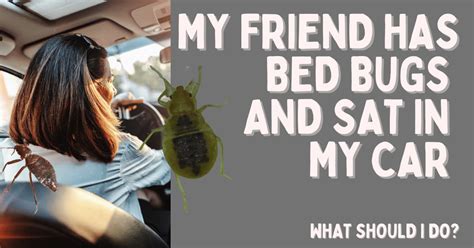Bed bugs are a common household problem that many people dread dealing with. However, when a friend or family member comes to visit and unknowingly brings bed bugs into your home or car, it can be a whole new level of stress and frustration. In this blog post, we will discuss the basics of bed bugs, how to identify signs of infestation, and how they can spread between environments. We will also explore the steps you can take to prevent bed bugs from entering your car, as well as how to clean and treat your vehicle if you suspect an infestation. Additionally, we will provide tips for protecting yourself and your home from contamination, as well as how to educate your friend about managing bed bugs. By the end of this post, you will have the knowledge and tools to handle the situation with confidence and prevent any further spread of bed bugs.
Understanding the basics of bed bugs
Bed bugs are small, reddish-brown insects that feed on the blood of humans and animals. They are nocturnal creatures that hide in cracks and crevices during the day and come out at night to feed on their hosts.
These pesky pests are often found in areas where people sleep, such as beds, couches, and even in vehicles. They can also be found in cluttered areas and are known to travel between dwellings through clothing, luggage, and furniture.
Female bed bugs can lay hundreds of eggs in their lifetime, making infestations difficult to eliminate without proper treatment. Understanding the behavior and habits of bed bugs is essential for effective eradication and prevention.
Therefore, it is crucial to educate yourself about the basics of bed bugs in order to protect yourself and your home from these unwanted intruders.
Identifying signs of bed bug infestation
One of the most important steps in dealing with a potential bed bug infestation is being able to identify the signs of their presence. Bed bug infestations can occur in any living environment, from homes to hotels to public transportation, so it is crucial to be able to recognize the warning signs.
One common sign of a bed bug infestation is the presence of tiny, reddish-brown bugs in the crevices of your mattress or other furniture. These bugs can be difficult to spot due to their small size, but they are visible to the naked eye. Additionally, another telltale sign is the presence of small, red bites on your skin, especially in rows or clusters. These bites can be itchy and uncomfortable, and they are often a sign that bed bugs are present in your living space.
Another sign of a bed bug infestation is the presence of small, rust-colored spots on your mattress or bedding. These spots are actually bed bug excrement, and they can often be found in areas where bed bugs hide during the day. Additionally, the presence of a musty odor in your living space can indicate a bed bug infestation, as these pests release pheromones that create a distinct smell.
Overall, being able to identify the signs of a bed bug infestation is crucial for taking prompt action to address the issue. By recognizing these warning signs, you can take steps to prevent the infestation from spreading and protect yourself from the nuisance and discomfort caused by bed bugs.
How bed bugs can spread between environments
Bed bugs are notorious for being excellent travelers, and they can easily spread between environments in a number of ways. One common way is through human travel. When people unknowingly pick up bed bugs from infested areas such as hotels, public transportation, or even friends’ homes, they can inadvertently transport the pests to their own living spaces.
Additionally, bed bugs can spread between environments through the movement of infested items. For example, bringing in used furniture, clothing, or luggage that has been exposed to bed bugs can introduce the pests into a new environment. It’s important to thoroughly inspect and clean any second-hand items before bringing them into your home.
Another way that bed bugs can spread is through neighboring units in multi-unit housing. If one unit becomes infested, the pests can easily travel through cracks in walls and floors to other units, leading to widespread infestations in the building. It’s crucial for all tenants to be proactive in addressing bed bug issues to prevent further spread.
Lastly, bed bugs can also spread between environments through the movement of people in shared spaces such as schools, offices, and healthcare facilities. The pests can hitch a ride on clothing or belongings and quickly infest new areas, making it essential to have proper protocols in place for managing and preventing bed bug infestations in these settings.
Steps to prevent bed bugs from entering your car
Preventing bed bugs from entering your car is crucial to avoid a potential infestation. One of the most effective steps is to regularly inspect your car for any signs of bed bugs. This includes checking the seams and crevices of the car seats, as well as the carpet and trunk area. If you happen to notice any red-brown insects or small reddish-brown spots on the upholstery, it may be a sign of bed bug presence.
Another important step to prevent bed bugs from entering your car is to avoid bringing infested items into your vehicle. If you suspect that any of your belongings are infested with bed bugs, it’s best to thoroughly inspect and treat them before bringing them into your car. Additionally, be cautious when picking up secondhand furniture or clothing, as these items can be potential carriers of bed bugs.
Furthermore, keeping your car clean and clutter-free can help prevent bed bugs from finding a hospitable environment. Vacuuming and regularly cleaning your car’s interior can eliminate potential hiding spots for bed bugs. It’s also important to seal any cracks or crevices in the car to prevent bed bugs from entering and establishing themselves.
Lastly, if you suspect that your car may be infested with bed bugs, it’s best to seek professional help for thorough inspection and treatment. Taking proactive measures to prevent bed bugs from entering your car can save you from the headache of dealing with a full-blown infestation.
Cleaning and treating your car for bed bugs
Once you’ve identified signs of bed bug infestation in your car, it’s crucial to take immediate action to clean and treat the vehicle. Bed bugs can easily spread from your car to your home or other environments, so it’s important to address the issue as soon as possible.
Start by thoroughly vacuuming the interior of your car, paying close attention to seams, crevices, and any areas where bed bugs may be hiding. Dispose of the vacuum bag or clean the canister outside of your home to prevent any bed bugs from spreading.
After vacuuming, use a steamer to treat the affected areas. The high temperatures of the steam will help to kill the bed bugs and their eggs, effectively eliminating the infestation in your car. Be sure to steam clean all upholstery, carpets, and other surfaces where bed bugs may be present.
Once you’ve completed the cleaning and treatment process, it’s important to take steps to prevent a future infestation. Regularly inspect your car for any signs of bed bugs, such as live bugs, eggs, or small dark spots on surfaces. If you frequently travel and stay in places that may have bed bugs, consider taking preventative measures such as using bed bug-proof luggage and regularly washing and drying your clothing at high temperatures.
Protecting yourself and your home from contamination
Protecting yourself and your home from contamination by bed bugs is essential in preserving your health and well-being. Bed bugs are small, reddish-brown insects that feed on the blood of humans and animals, and they can easily spread from one environment to another if proper precautions are not taken.
One of the best ways to protect yourself and your home from bed bug contamination is to regularly inspect your living space for any signs of infestation. This includes checking your mattress, bed frame, and other furniture for visible bugs, eggs, or fecal stains. Additionally, be mindful of any unusual bites or red, itchy welts on your skin, as these could be a sign of bed bug bites.
Another important step in preventing bed bug contamination is to be cautious when traveling or staying in new environments. Always inspect hotel rooms or rental accommodations for any signs of bed bug activity before unpacking your belongings. It’s also a good idea to keep your luggage elevated and away from the bed and furniture to minimize the risk of bringing bed bugs home with you.
Lastly, if you suspect a bed bug infestation in your home, it’s crucial to act quickly to prevent the problem from spreading. Contact a professional pest control service to assess and treat the infestation, and follow their guidance on cleaning and treating your living space to eliminate bed bugs effectively.
Educating your friend about bed bug management
When it comes to bed bug management, it’s important to not only protect yourself and your home, but also to educate those around you about the potential risks and prevention methods. One way to do this is by educating your friends about bed bug management so that they can also take necessary precautions to avoid infestations.
Start by explaining to your friend the basics of bed bugs and how they can easily spread from one environment to another. Emphasize the importance of being proactive in preventing bed bug infestations in their own homes by keeping a clean and clutter-free living space.
Additionally, it’s crucial to inform your friend about the common signs of a bed bug infestation, such as small red bites on the skin and small bloodstains on bedding and furniture. By teaching them what to look out for, they can take action early on if they suspect a potential infestation.
Finally, provide your friend with practical steps to prevent bed bugs from entering their home, such as inspecting second-hand furniture before bringing it indoors, washing bedding and clothes regularly, and using protective mattress and box spring encasements.







